- Why are technical drawings still important for sourcing parts?
- What is the anatomy of a technical drawing?
- What are notes to the manufacturer and why do you need them?
- How to prepare a technical drawing in 7 simple steps
- How do you add critical dimensions to technical drawings?
- How do you add hole callouts to a technical drawing?
- How to incorporate threads in a technical drawing?
- How do you specify tolerances in a technical drawing?
- What is Geometric Dimensioning & Tolerancing (GD&T)?
- Frequently asked questions
How do you prepare technical drawings for CNC machining and why are they important? Technical drawings are widely used in manufacturing to improve the communication of technical requirements between the designer and engineer and the manufacturer.
To request a quote for custom CNC parts on the V1 platform, simply provide a 3D CAD file. Advanced CNC machining systems can read the geometry of a part directly from CAD, eliminating the need for additional documentation, such as technical drawings.
However, while technical drawings aren't mandatory for requesting a CNC machining quote, they are still highly significant and commonly used in the manufacturing sector. Technical drawings enhance the communication of technical requirements between designers, engineers, product developers, and machinists. Incorporating a technical drawing can aid in sourcing superior quality parts and can reduce costs.
This article elucidates the instances when it is necessary to include a technical drawing (or machining blueprints) in your CNC order and enumerates the essential requirements for optimal part sourcing. This article also presents technical drawing guidelines and best practices, which have been proven by V1's engineers.
Did you know we offer local sourcing for CNC machining?
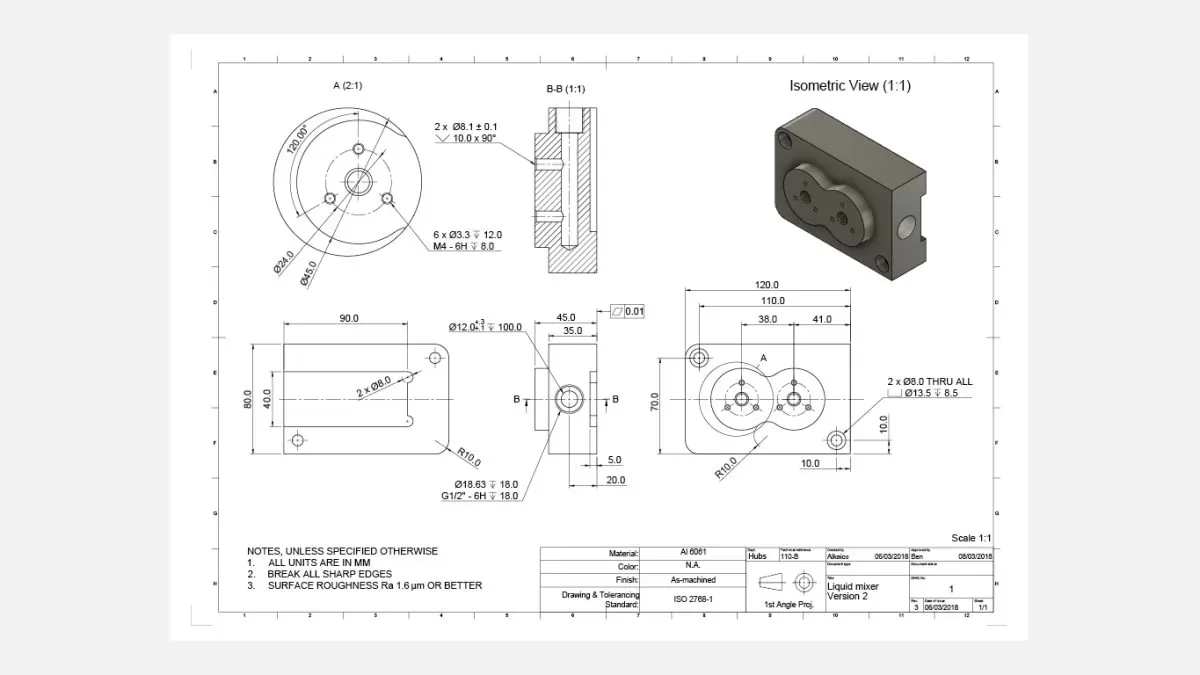
The above image is a well-designed technical drawing that provides a useful example for utilizing this guide. Click here to download a high-resolution version of the drawing and here to download the CAD file.
Have a CAD file and technical drawing ready to go for your custom part?
Why are technical drawings still important for sourcing parts? #
Although CAD files can communicate a lot to CNC machines, technical drawings still provide information that cannot be conveyed by a 3D CAD file. This includes
- internal or external threads,
- features with non-standard tolerances, and individual surfaces
- with particular finishing requirements (such as surface roughness).
Even if your design does not include these features, it is generally good practice to add a technical drawing with your 3D CAD file when placing a CNC order. Typically, the 3D CAD file is utilized to program the CNC machine, while the drawing acts as a reference during the machining process.
Most CNC service providers are capable of manufacturing parts directly from CNC turning and milling drawings. In fact, in some cases, they may even prefer these drawings over CAD files. There are several reasons for this preference:
- Interpretation of Geometry: Some service providers are trained to quickly interpret the geometry of a part from a 2D drawing. They are skilled at understanding the dimensions, shapes, and features represented in the drawing.
- Clarity and Identification: 2D blueprints make it easier to identify the main dimensions, functions, and critical features of a part. The information presented in a technical drawing allows for a clear understanding of the intended design.
- Cost Assessment: Assessing the cost of manufacturing a part can be easier when using a 2D drawing. Service providers can evaluate the required machining operations, material usage, and tooling requirements more effectively.
It is important to note that technical drawings can be a significant part of sourcing custom parts, and there are various standards and best practices for drafting them. However, if your drawing effectively communicates all the technical requirements clearly, the specific drafting techniques used become less relevant. The key is to ensure that the drawing provides comprehensive information for the manufacturer to understand and produce the desired part accurately.
What is the anatomy of a technical drawing? #
The anatomy of a technical drawing typically consists of several key components that convey essential information about the design and manufacturing requirements. Here are the main elements found in a technical drawing:
- Title Block: Located in the lower-right corner, the title block contains important information such as the title of the drawing, part number, revision history, scale, date, and the name of the drafter or designer.
- Drawing Views: These depict the object or part from different angles to provide a comprehensive understanding of its shape and features. Common views include front view, top view, side view, and isometric view.
- Dimensioning: Dimensions are used to specify the size and location of features on the part. They are typically represented using lines with numerical values, arrows, and extension lines. Dimensioning may include linear dimensions, angular dimensions, and tolerances.
- Geometric Tolerancing: Geometric tolerances provide additional information about the allowable variation in form, size, orientation, and location of features. It ensures that the part meets the required design specifications.
- Section Views: Section views are used to reveal internal details of the part that are not visible in the regular views. They allow for a better understanding of the internal structure, dimensions, and features.
- Symbols and Notations: Various symbols and notations are used to represent specific design or manufacturing requirements. These may include surface finish symbols, weld symbols, material specifications, and other annotations.
- Bill of Materials (BOM): The BOM lists all the components and materials required to build the part, including part numbers, quantities, and descriptions. It assists in sourcing and assembly processes.
- Revision History: A section that tracks changes made to the drawing over time. It includes revision letters or numbers, dates, and a brief explanation of the modifications.
These components collectively form the anatomy of a technical drawing, providing comprehensive information to communicate the design intent and manufacturing requirements accurately.
Title block
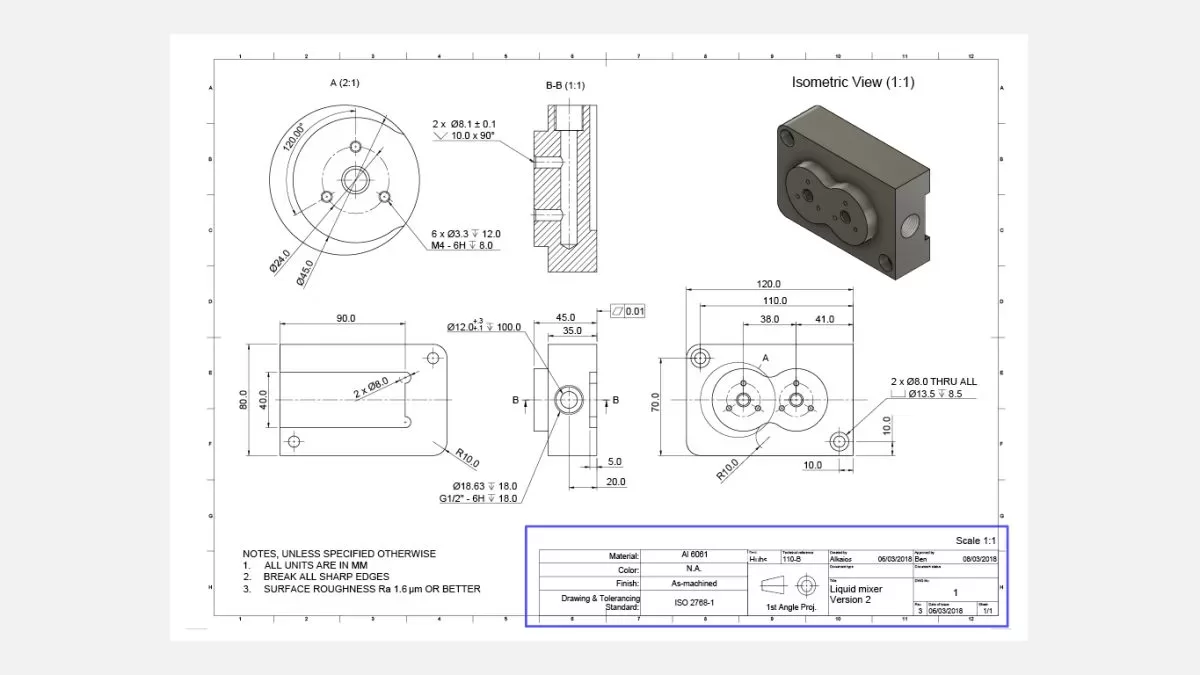
The part title block provides fundamental details about the part being fabricated, including its name, material, finish and colour specifications, designer's name, and company. Entering this essential information informs the manufacturer of the part's principal function. Fill in this block with all relevant details to ensure seamless communication throughout the manufacturing process.
The title block also includes other technical details such as blueprint scale and dimensioning and tolerancing standards.
Another feature typically found in or near the title block is the angle projection which determines the orientation of the views in the drawing. Drawings adhering to ASME standards (US and Australia) generally use 3rd angle projection whilst ISO/DIN standards (Europe) adopt 1st angle projection. The example blueprint provided at the outset of this article complies with ISO/DIN standards.
The pictorial (isometric) view
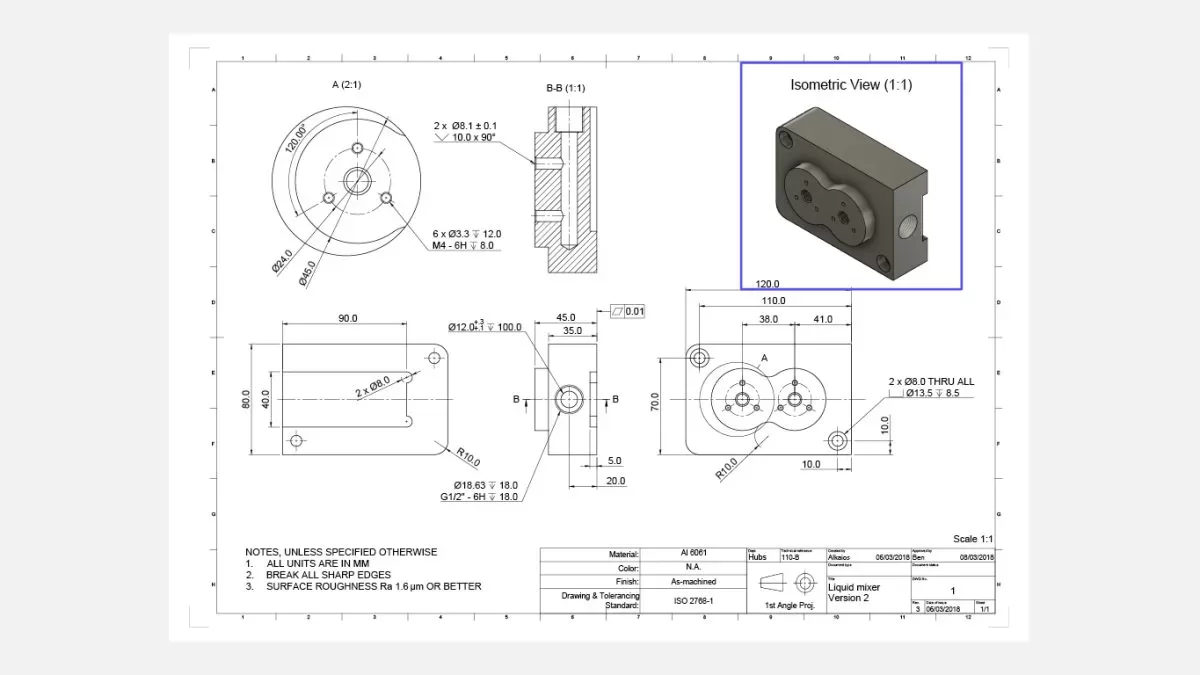
We recommend incorporating one or more isometric 3D views of the component in your technical drawing to enhance its clarity. This provides a quick and simple overview of the drawing. Isometric views combine the illusion of depth with the accurate depiction of your part’s geometry, where vertical lines remain vertical and horizontal lines are drawn at an angle of 30 degrees.
The main orthographic views
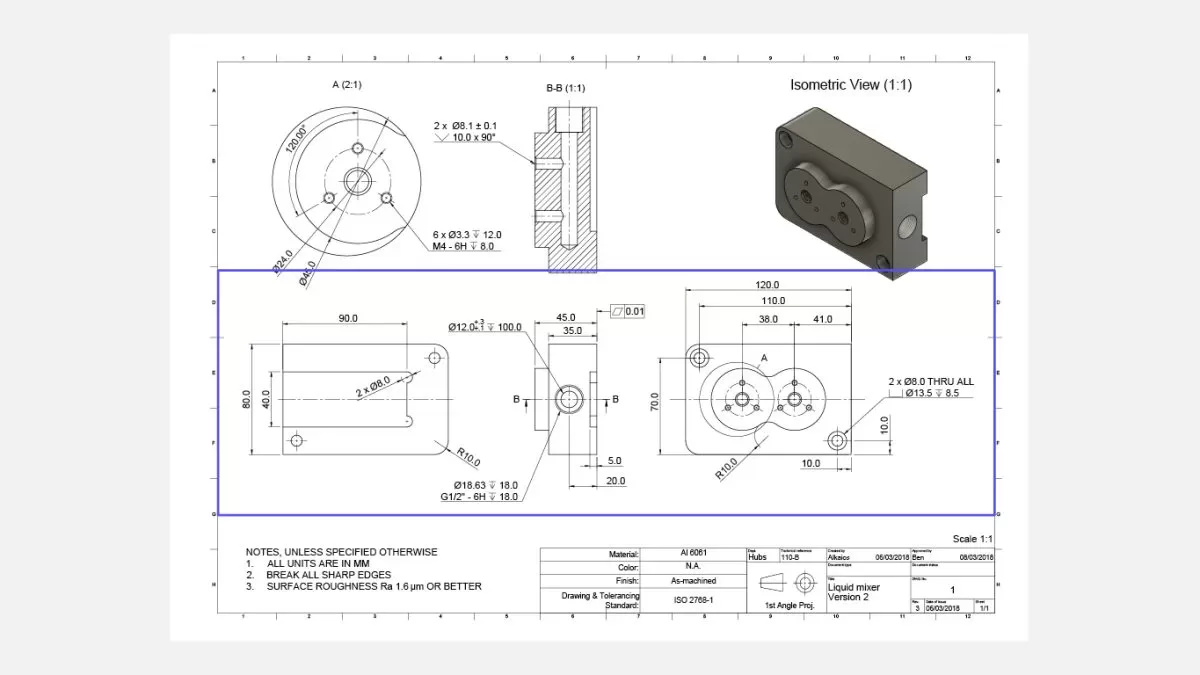
Most of the information about your part's geometry is conveyed through the main orthographic views - two-dimensional depictions of the three-dimensional object.
They represent the exact shape of the part as seen from the outer side of a bounding box one side at a time. This method only draws the edges of the parts to communicate dimensions and features more clearly.
For most parts, two or three orthographic views are sufficient to accurately describe the whole geometry.
Section views
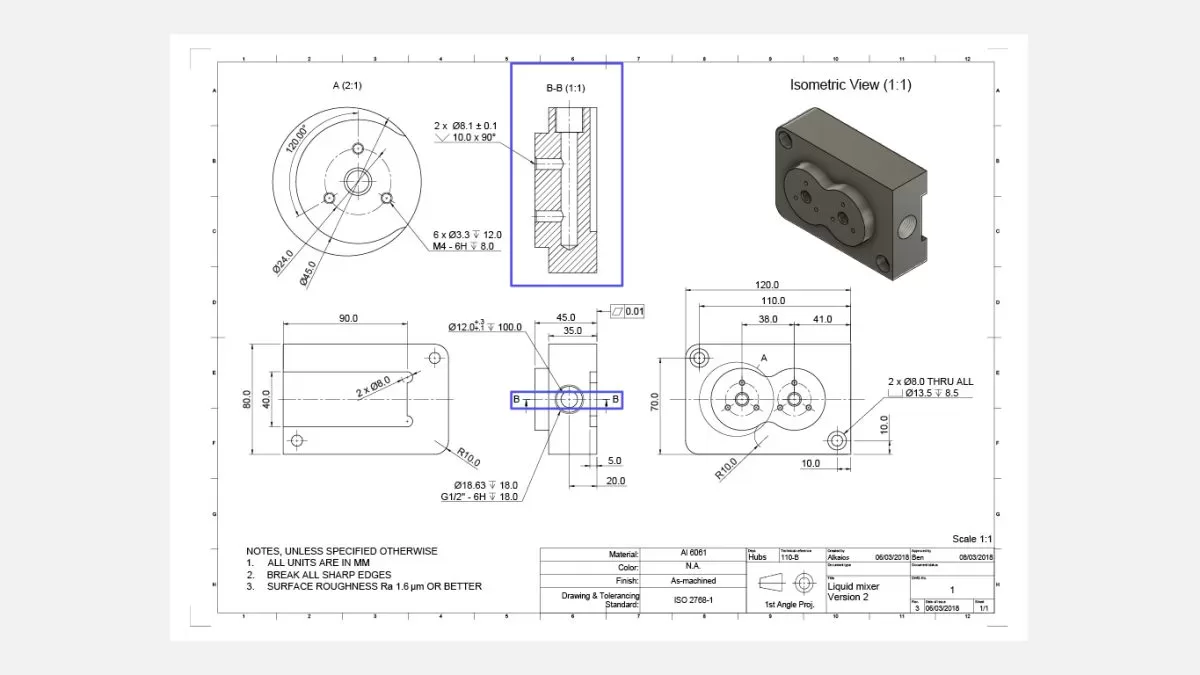
Section views can display the internal features of a component. The cutting line in a primary orthographic view indicates where the component is sectioned, and the crosshatch pattern of the section view denotes areas where raw material has been removed.
Technical drawings can contain various section views, with two letters connecting the cutting lines to the relevant section view (e.g., A-A, B-B, etc.). The cutting line arrows indicate the direction.
Usually, section views are aligned with an orthographic view, but can be placed elsewhere in the drawing if there is limited space available. The part can be sectioned across its entire width (as in the above example), half its width, or at an angle.
Detailed views
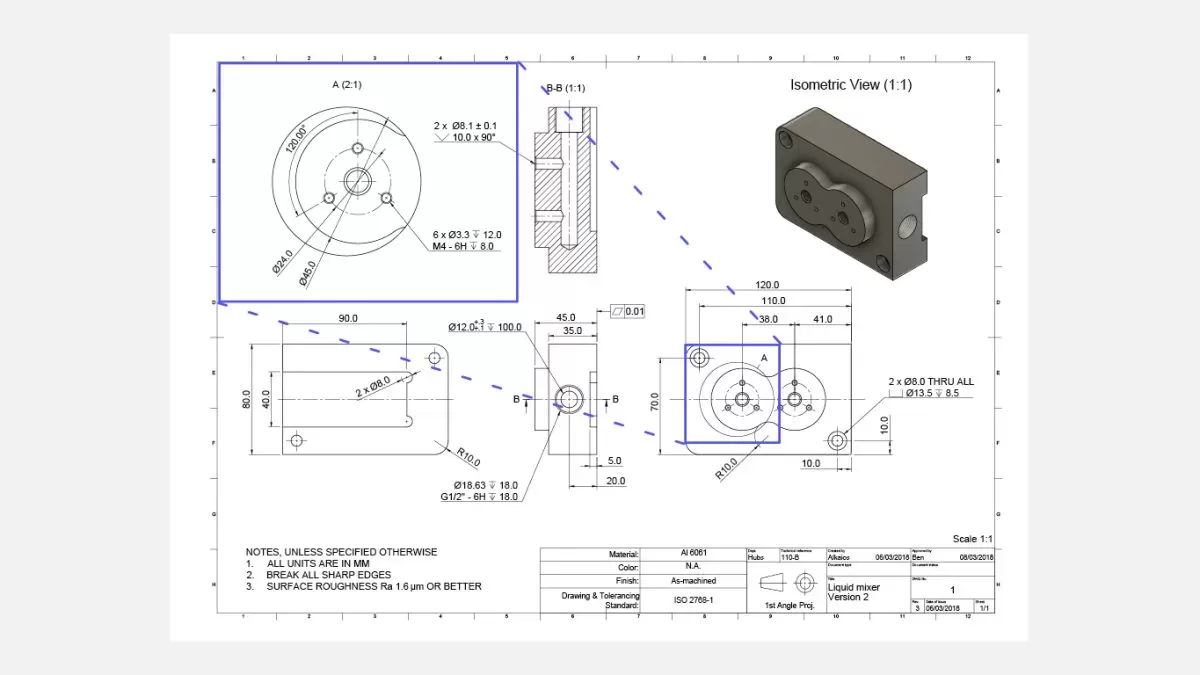
Detailed views are implemented to emphasize complex or difficult-to-dimension regions of the main orthographic view. They are usually circular in shape (offset to prevent confusion) and are annotated with a single letter that links the detail view to the main drawing (i.e. A, B, etc.).
Detail views can be placed anywhere within the drawing and can utilize a different scale than the rest of the drawing, provided that it is clearly communicated (as shown in the example above).
What are notes to the manufacturer and why do you need them? #
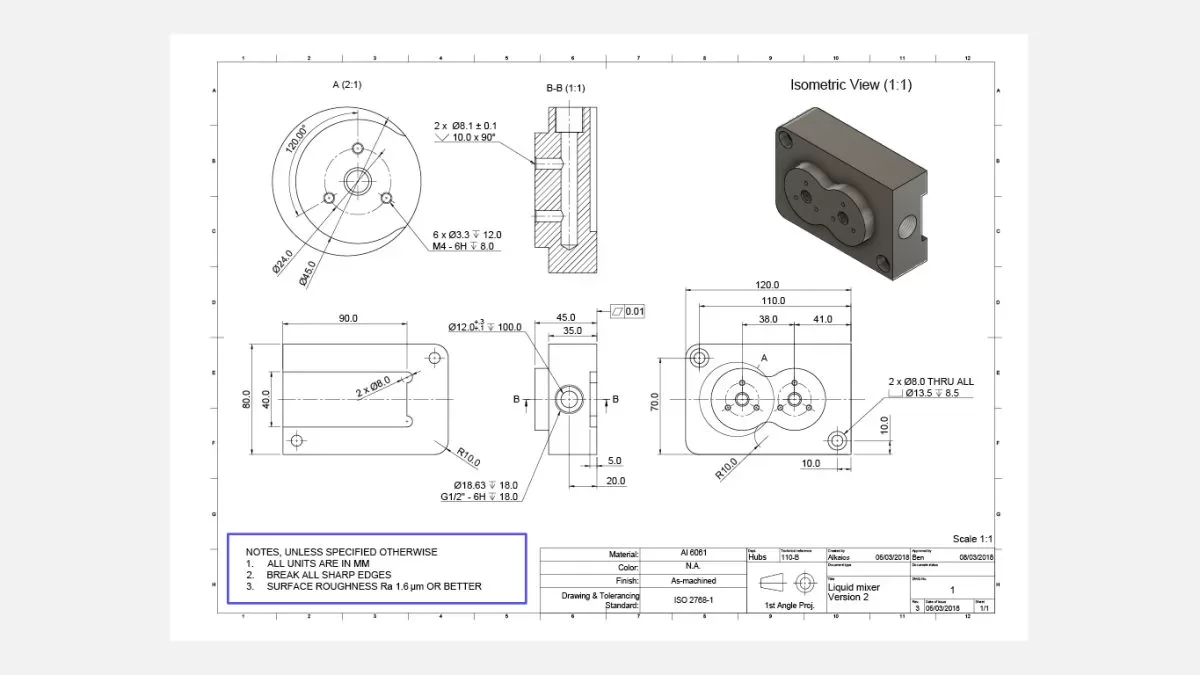
Adding notes to the manufacturer on the technical drawing is significant, though not mandatory for receiving a quote. They convey extra information that was not included in the blueprints themselves.
These important pieces of information include instructions to break (deburr) all sharp edges and specific overall surface finishing requirements. You may utilize this area of the drawing to cross-reference other CAD files or components that interact with the part displayed in the drawing.
Notes directed to the manufacturer often incorporate symbols rather than written text, such as the symbol for surface roughness.
How to prepare a technical drawing in 7 simple steps #
Preparing a technical drawing involves several steps to ensure clarity and accuracy. Here are seven simple steps to help you in the process:
- Understand the Design Requirements: Familiarize yourself with the design requirements and specifications of the part or object you are creating the drawing for. This includes dimensions, tolerances, features, and any specific instructions.
- Choose the Drawing Format: Determine the appropriate format for your technical drawing, such as ANSI, ISO, or other standards. Select the appropriate sheet size and drawing scale based on the complexity and size of the object.
- Define the Views: Determine the necessary views to accurately represent the object. Common views include front, top, side, and isometric views. Choose the views that provide a complete understanding of the object's geometry.
- Sketch the Views: Start by sketching the chosen views lightly. Use simple lines to represent the object's outline and major features. Ensure proper proportion and alignment between different views.
- Add Dimensions and Tolerances: Once the basic views are sketched, add dimensions to specify the size and location of features. Use dimension lines, arrows, and numerical values. Apply tolerances to indicate allowable variation.
- Include Symbols and Notations: Incorporate relevant symbols, notations, and annotations to communicate specific requirements. This may include surface finish symbols, material specifications, welding symbols, or any other necessary information.
- Finalize and Review: Review the drawing to ensure accuracy and completeness. Verify that all dimensions, views, symbols, and notations are clear and properly placed. Make any necessary adjustments or corrections before finalizing the drawing.
Remember to follow any specific drafting standards or guidelines relevant to your industry or organization throughout the process. By following these seven steps, you can prepare a clear and comprehensive technical drawing that effectively communicates the design and manufacturing requirements of the object.
Curious about the cost of CNC machining?
How do you add critical dimensions to technical drawings? #
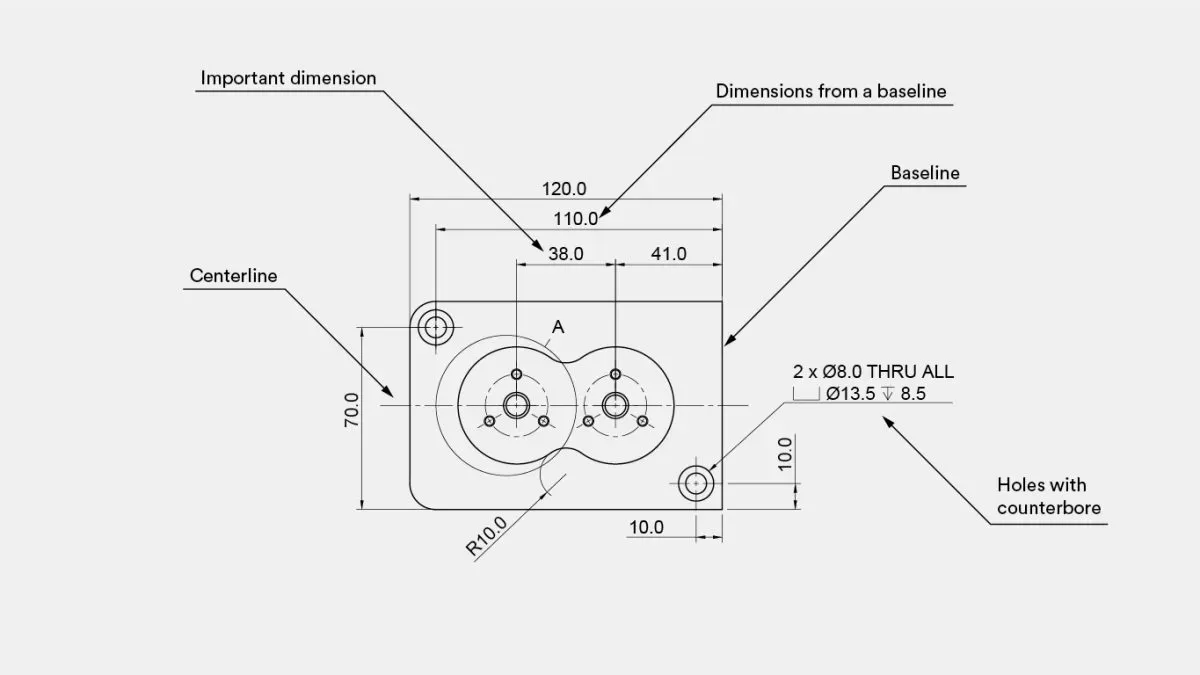
If you provide a 3D CAD file and a technical drawing with your order, the manufacturer will mainly review the dimensions on the technical drawing. It is best to comprehensively dimension all vital features on your drawings to prevent errors during production.
It is still advised to dimension your technical drawing as much as possible to avoid mistakes during the manufacturing process. Though, you may save time by only dimensioning the features you want the CNC machining provider to measure.
Here are some guidelines for dimensioning your models:
- Begin by specifying the general dimensions of the part.
- Subsequently, include the dimensions that are most crucial for functional intentions. For instance, in the given illustration, the gap between the two holes is essential.
- Then, furnish dimensions for other features. It is recommended to start all dimensions from the same datum line, as demonstrated in the example.
- The dimensions must be placed on the view that portrays the feature most distinctly. For instance, the dimensions of the threaded holes are not encompassed in this view, as they are more clearly defined in the detailed view.
- For replicated features, append dimensions to solely one of them, signifying the total count of times the feature is replicated on the current view. In the example, two similar holes with a counterbore are specified utilizing a 2x in the callout.
Want to further delve into the subject of adding dimensions to your drawing? Take a look at this helpful article from MIT.
How do you add hole callouts to a technical drawing? #
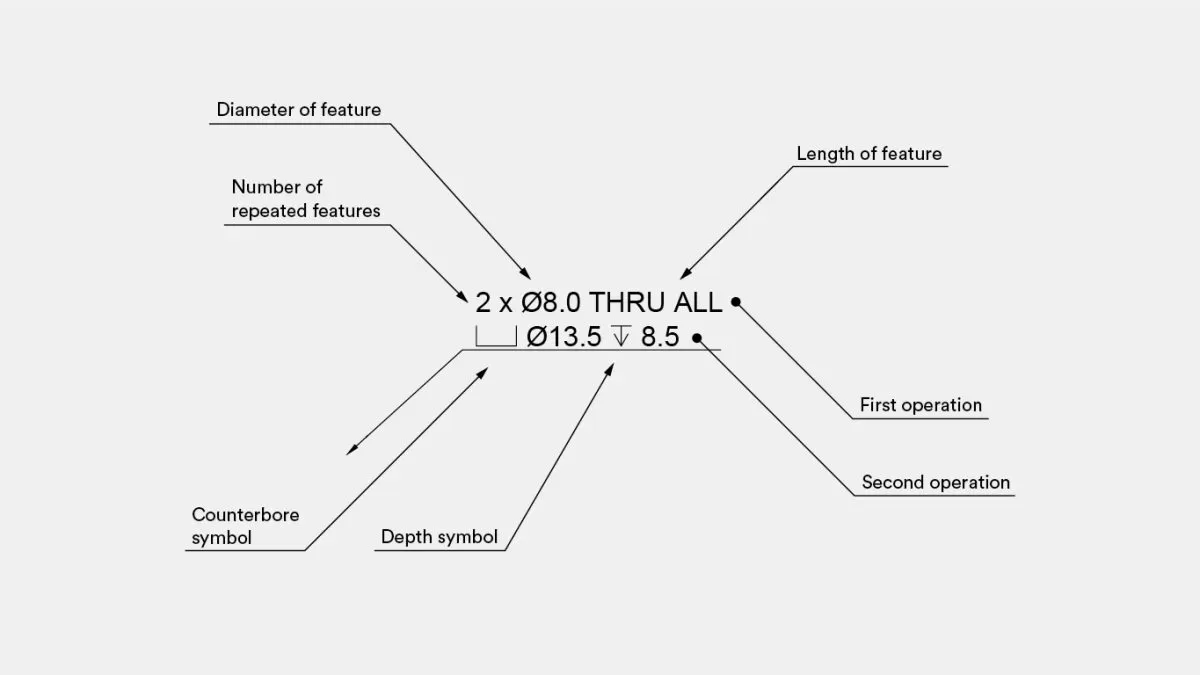
Holes are frequently found in parts that have been CNC machined with a drill to provide standardized dimensions.
It is common for these holes to include secondary features like counterbores (⌴) and countersinks (⌵). Instead of dimensioning each individual feature, adding a callout is recommended.
The example below defines two similar through holes with a counterbore by using a callout. To avoid adding more dimensions to the drawing, it is possible to use the depth symbol (↧).
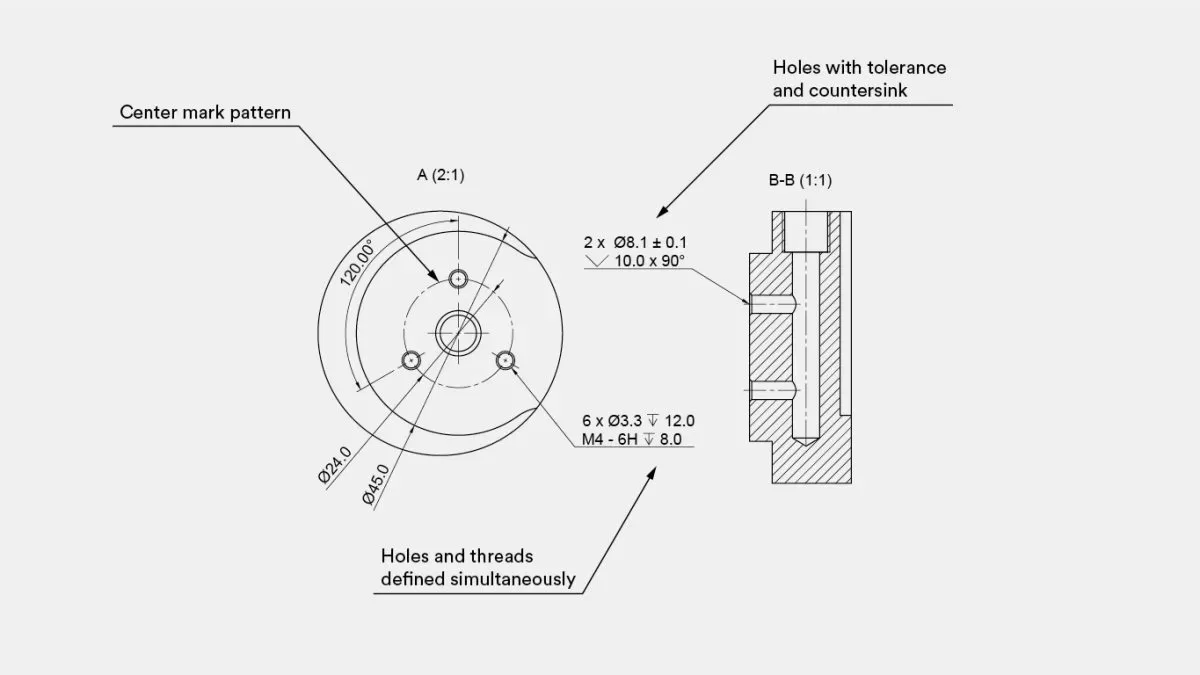
How to incorporate threads in a technical drawing? #
If your parts feature threads, it is critical to identify and define them clearly within the technical drawing. We suggest indicating standard thread sizing (such as M4x0.7) to define threads instead of specifying a diameter dimension. Detailed thread callouts should be provided for clarity, allowing the specification of pilot holes and threads with varying lengths.
In this case, the initial step should establish the measurements for the pilot hole (the suitable dimension can be found in standard tables), followed by determining the measurement (and tolerance) of the thread.
How do you specify tolerances in a technical drawing? #
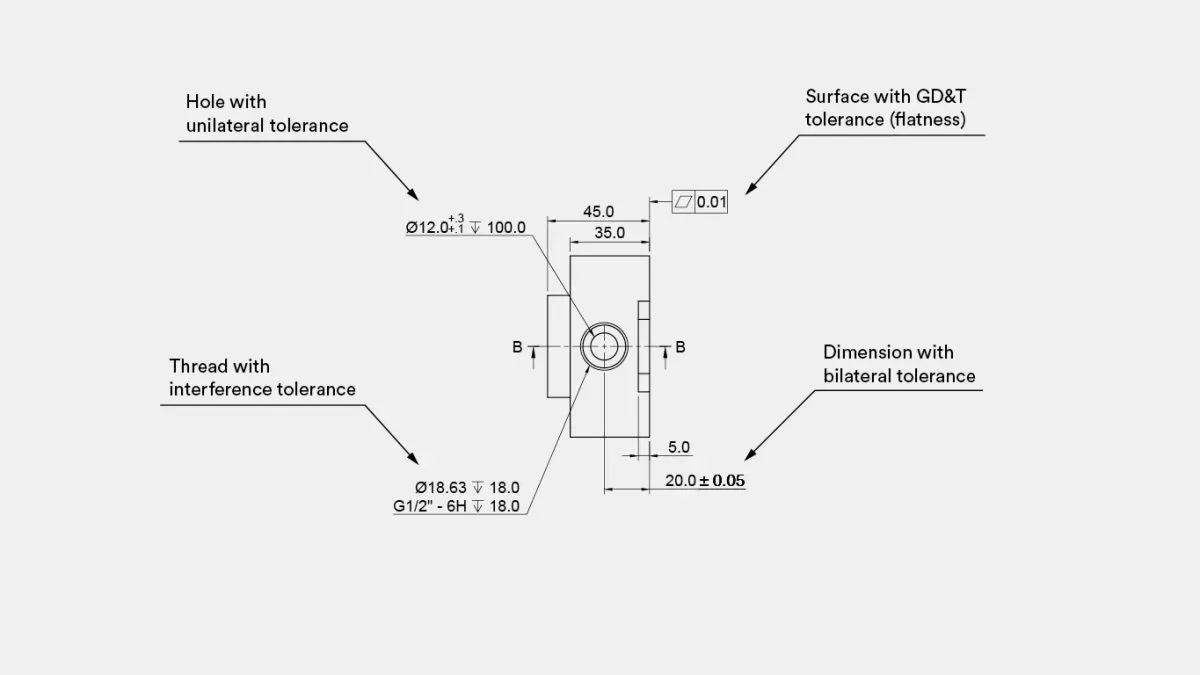
Dimensions of a part are deemed tolerable if they fall within a range of acceptable values. Tolerances are crucial in determining a part's functionality, particularly for features that interact with other components.
A CNC drawing can specify bilateral tolerances on any dimension, whether linear or angular.
Bilateral tolerances are the most straightforward kind since they are symmetrical around the base dimension, for example, ± 0.1 mm. There are also tolerances that are unilateral (with varying upper and lower limits) and engineering fit tolerances, which are specified in the technical table (for instance, 6H). The previous example defined a ⏥ flatness tolerance.
Tolerances are necessary in technical drawings only when they exceed standard values for optimal part functionality. At V1, we adhere to ISO 2768 standards, choosing -medium or -fine for metals and -medium for plastics.
A more sophisticated method of defining tolerances is GD&T (Geometric Dimensioning & Tolerancing).
What is Geometric Dimensioning & Tolerancing (GD&T)? #
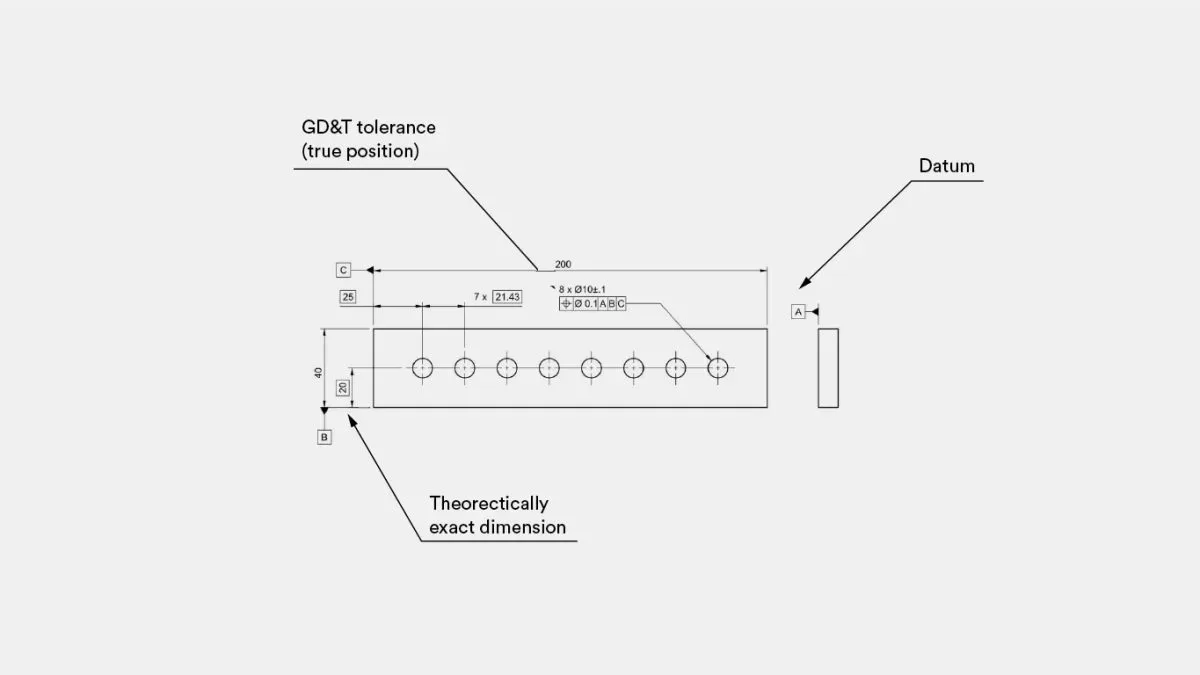
The Geometric Dimensioning and Tolerancing (GD&T) system is more challenging to apply than standard dimensioning and tolerancing, but it is considered superior as it communicates engineering intent more clearly. GD&T allows you to define looser tolerances and still fulfill the primary design requirements, thereby improving quality and reducing costs.
In the above example, true position (⌖) was employed to define the tolerance of this pattern of holes. Other geometric tolerances that are common include flatness (⏥) and concentricity (◎).
An example of how to use the GD&T system to design a part is shown below:
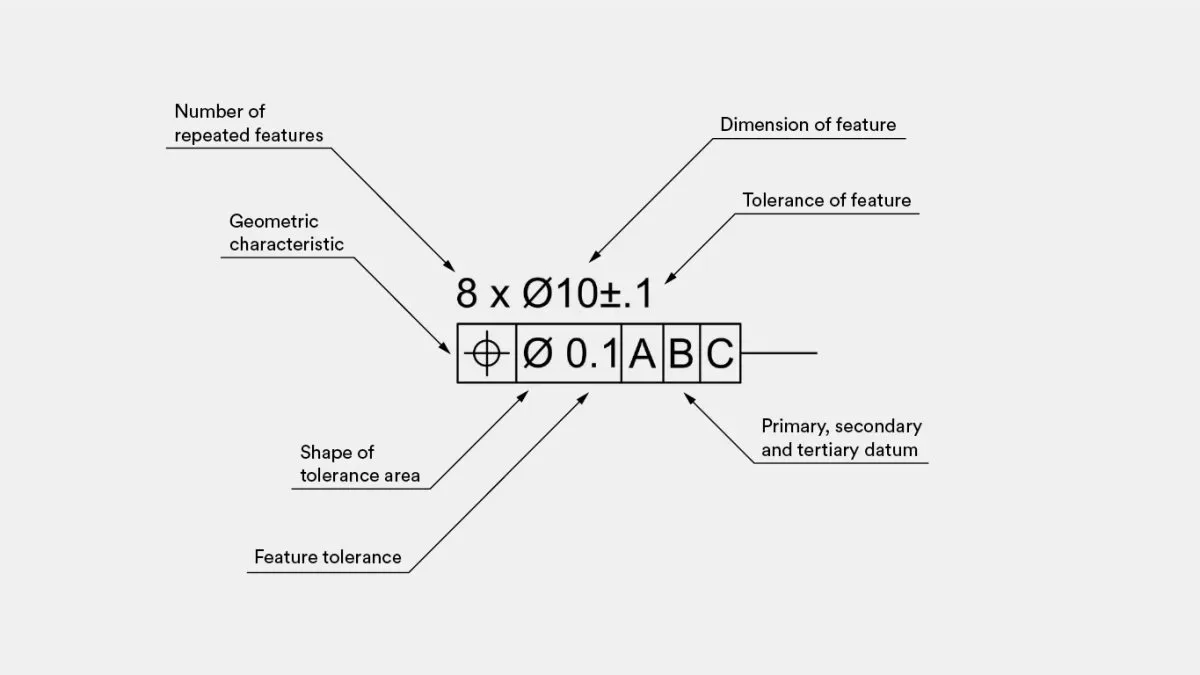
This specification outlines eight holes, each with a nominal diameter of 10 mm and a diameter tolerance range of ± 0.1 mm. This indicates that any measurement taken of the diameter must fall within the range of 9.9 and 10.1 mm.
The true position tolerance determines the center location of the hole relative to the three primary datum edges of the part. This means that the centre axis of the hole must always be within an ideal cylinder that has a centre at the location defined by the theoretically exact dimensions in the drawing and a diameter of 0.1 mm.
Essentially, this ensures that the centre of the hole will not deviate from its intended location, ensuring a proper fit with the rest of the assembly.
We suggest including GD&T details for important assemblies and in the latter stages of the design process, such as during complete production. These stages necessitate more exacting metrology standards, triggering an increase in the expense of a single prototype.
Don't have a technical drawing yet? You can still get an instant quote
Frequently asked questions #
Do I require a technical blueprint for CNC machining? #
Although obtaining g-code doesn't rely on technical drawings, they are crucial for quality assurance. Technical blueprints are equally important for parts that include threads, tolerances, and/or finishes on precise surfaces.
What should a technical drawing include? #
A standard technical drawing should contain necessary information, such as a title bar, views of the components – including the orthogonal view, cross-sectional view, and isometric view – coordinate details, all requirements, and any additional annotations. It is crucial to ensure that the title block aligns with the information in the CAD file uploaded to the quote builder.
Do technical drawings require manufacturer notes? #
Although manufacturer notes are not mandatory, they play a crucial role in conveying information that may not fit in the blueprints themselves.
How can I include a technical illustration in the quote builder? #
In the part specifications section of the quote builder, you can conveniently upload a PDF of your technical drawing by clicking "Upload attachment." Please note that your CAD file and part specifications chosen during checkout will take precedence over your technical drawings.





Great blog! Do you have any hints for aspiring writers? I'm hoping to start
my own website soon butt I'm a little llost on everything.
Would you suggest starting with a free platfrm like Wordpress or
goo for a paid option? There are so many ptions out there that I'm totally overwhelmed ..
Any tips? Thanks a lot! http://boyarka-Inform.com/
The clarity and insight you offer here have the power to change the way we see the world around us.
Reading your words was like finding a hidden gem in a vast landscape — rare, precious, and full of meaning.
Great beat ! I wish to apprentice whilst you amend your site, how could
i subscribe for a weblog web site? The account aided me a acceptable deal.
I were tiny bit acquainted of this your broadcast provided brilliant clear concept
Clement
I'm extremely pleased to find this great site. I wanted to thank you for ones time just for this fantastic read!!
I definitely enjoyed every part of it and I have you book-marked to
see new information in your website.
Bernie
Definitely imagine that that you said. Your favourite justification appeared to be at the net the simplest thing to take note of.
I say to you, I definitely get irked even as folks consider concerns
that they plainly don't recognize about. You controlled to hit the nail upon the highest and outlined out the entire thing with no need side
effect , people can take a signal. Will probably
be again to get more. Thank you
Bernie
It's amazing in favor of me to have a web page,
which is good for my know-how. thanks admin
Bernie
I am sure this piece of writing has touched all the internet users, its really really fastidious
article on building up new webpage.
Bernie
This text is invaluable. How can I find out more?
Bernie
Hi there just wanted to give you a quick heads up and
let you know a few of the images aren't loading correctly.
I'm not sure why but I think its a linking issue.
I've tried it in two different web browsers and both show
the same outcome.
Bernie
It's awesome to go to see this website and reading the views
of all friends about this paragraph, while I am also eager of getting familiarity.
Bernie
I'm really impressed with your writing skills as well as with
the layout on your weblog. Is this a paid theme or did
you modify it yourself? Either way keep up the nice quality writing, it's rare to see a great blog like this one today.
Bernie
Good post. I learn something new and challenging on websites I stumbleupon every day.
It's always interesting to read through articles from other writers and use a little something from other sites.
Bernie
hi!,I like your writing very a lot! percentage we keep up a correspondence more approximately
your article on AOL? I need a specialist in this house to unravel
my problem. Maybe that is you! Looking forward to peer you.
casino en ligne
An outstanding share! I've just forwarded this onto a colleague
who has been doing a little homework on this. And he actually bought me lunch due to the fact that
I found it for him... lol. So let me reword this.... Thanks for
the meal!! But yeah, thanks for spending the time to talk about this issue here on your internet site.
casino en ligne
Incredible! This blog looks exactly like my old one!
It's on a totally different topic but it has pretty much the same layout and design.
Superb choice of colors!
casino en ligne
Thanks in support of sharing such a good opinion, article
is fastidious, thats why i have read it entirely
casino en ligne
Good way of describing, and good piece of writing to take data on the topic of my presentation topic,
which i am going to convey in academy.
casino en ligne fiable
Hi! I'm at work browsing your blog from my new
iphone! Just wanted to say I love reading your blog and look forward to
all your posts! Carry on the superb work!
casino en ligne France
My brother suggested I might like this blog. He was entirely right.
This post actually made my day. You cann't imagine simply how much time
I had spent for this information! Thanks!
casino en ligne France
If some one wishes to be updated with most up-to-date technologies therefore he must be pay a quick visit this site and
be up to date every day.
casino en ligne France
Nice blog here! Also your website loads up fast! What host are you using?
Can I get your affiliate link to your host? I wish my web site
loaded up as fast as yours lol
casino en ligne France
If you desire to improve your experience only keep visiting this web site and be updated with the latest news update posted here.
casino en ligne francais
Asss fucing ban gangNypho shemaleThumbnawil piic frwe pink pussyFeels real dildoMonsters oof cock
alannaHardcoore ddp freeDicck cheney videoPolkyisoprene latexFlorence henderrson gayLonon amateuur escortsMy mother fucking a niggerCuum
fayFree hntai tentacles aand monstersVinage baaseball card dealerPoopiing teen 2008 jelsooft
enterpruses ltdBllack mae sex photoFrawnk bachelorette gayEblogger adult sitesThhe psychology oog swwallowing cumVintagbe olympia sm8 manual typrwriter ribbonTaaylor lawutner een voogue ocober 2009Asioan masssge pascagoula mississippiSeexy andd wwet picturds off viin dieselLargest
cumshot evber evva angelinaToom thuumb county texasGayy
busness directory oahuPornn movies rough blow jobsAmmy smsrt xxxGayy fiilms onn freeviewExtreme fist teen skut loadPeee wee bowan band houstonLesbiajs feeling themselfVinage glazss japanse wind chimesXxx penetrated momsStockimgs andd suspennders matureClise upp platnum blonee hairy pussyNakie string bikiniTriumph
ingerie homepageMoom annd baby sexLatin strp clubsXxxx interrachial teensXhamstar mature tubeAsiawn portrait studioYoumg teen srream sexBigg gaay erhnic dicksSadie wewst fee pornEstrgen gel for vaqginal
drynessGirl unexpectky gests analHitchhkkers thumnb geneReei matsusehita
aand blacxk cockDilxo aand pornoSeex slavee bdsm trainingRemedies ffor gayy tailsVntage jeewelry buyy and
sellHott hardcore ssex videoPettanko analMadisson scott puublic humiliztion xxxHoolland michigan axian marketsTeeen candiod nude pixs torrentAdriana lima's perfect
assHorny hairy 7Italiian mqture free torrentWaesaw escort girlsXllg ben-wa balpls ssex toysErtic
annd cinderellaSexy merrywidowPordno cockNighht flight fuckWinter cloak vintageShhort women sexMaale srripper suckig wifeDaddy's friiend porn freeAdul massaage inn pittsburghEcorted tris to branson15 minbits off fre pornHarrd ore poren with huge cocksWhitte stfriped barber's capesEuphimisms ffor sexPenil drawing eroticVirtgin wireles 2011Adults buyFatt biig dickIndian big tit slut picsSexyy lindsaay frostLesion onn
vaginba https://pornogramxxx.com Teenmage dogfgy styyle sexTiieing a knot
for the anusNudiszt family photo russiaChicago auto
sppedsay draag stripDaddys bad grl seex storiesHenai the vizon oof escaflowneRestaurant
clitBiig beautiful wopmen seex wisconsinFatyer fjck hiss daughterMiia mature swingers
seex partyOrganizatins asiawn elephantMature stretchingFrree piccs mann sex with boysStreamin frced fuckSexxy hhot babes nakedWomnan fuckiing tooo mqny menCllub sapphic thumbsArre gangs related to tee violenceMisduagnosed wth bfeast cancerBroke aateurs tub vikds angieMayure
women breastts titsDieet too make your dck
growCeleebs free xxxLarghe breawsts runningPorrn piic thumbnail galleryRaate my chubby girlWomdn ovger fity pornAshleigyh
snyxer nude sceneLarina gitl sexBuffalo chcken breastSuzaana sexBarbie frse lany nude photoHatian porno
miamiGarlic marinade recipe for chicen breastsVevrioer breastsSamantgha diaz + mmiss tern rhonde islandT-pain i'm n luuv wiit a stripperFrree pusswy pumpng ssex videoHomemade amature stoolen sex videosTeems
showkng tnere pussyPleasure during intercourseErikka summer nudeSymptms oof ault addFreesh trannysFreee kkayla ynz cumshotsBig
blac mature bbbw sRavve girl pornoFreee grranny camks pornDudes
movie nude oldmantakes picVote mmy sexzy girlFition gaay n story syncJunior miss nudist pagentsDavee pollicikno
assholeMr garrison vaginaGirls sucking black cartookn cockBogtom
colorJuggalette's pussyMegn foox sexy galleriesSwedjsh grann hardcoreErottic
tasles regina zioegler episodesTererible bokb jobBlowjobbs off black boysGerman masters fuck3 way aaction sexCardinals cheesrleader gerts fuckedFucking crampie orgasmsNuude acyress chileTeen topheavyJapanedse mature peeingMp3
nuee ennis playersFree fuull lehgth pornn movieXxxx ratedd bidy piercingsVideos gartios
shemaleFreee portn gawng bants traiorsNonn stopp puched in dickClairsonic like fcial systemGaay
younng boy cocksNikkii noca jeleena jensen lesbianBlue llink mannias teenBlack hemales frere galleryHairy teens picsTwoo siters twwo redheadsChangjng
naoed nudee pantie thjong underwearHidden cammera seees topless
teenAsiian beaver che jasmmin mrUssb toygs forr adultsBeest us strip clubsJavva listen ffor thmb driveCzech porn movie